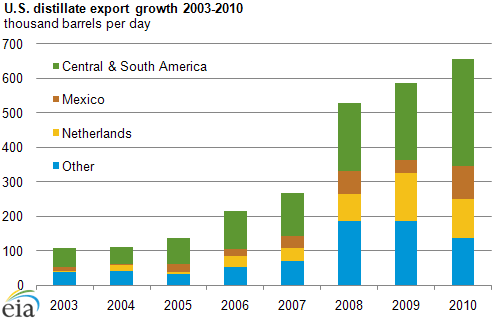
U.S. distillate fuel exports continue to grow

Download CSV Data
U.S. exports of distillate fuel (which includes diesel) reached a record 656,000 barrels per day (bbl/d) in 2010 and have grown every year since 2003. That trend continued during the first six months (the most recent for which data are available) of 2011, with diesel exports averaging 730,000 bbl/d, a 32% increase over an average of 554,000 bbl/d during the same period in 2010.
Increases in U.S. distillate exports began as global diesel consumption growth outpaced growth in consumption of other petroleum products over the past decade. According to the International Energy Agency, from 2000 through 2008 (the last year for which a complete set of global data exists), global diesel (also called gasoil in some parts of the world) consumption increased by 23%, while consumption of other petroleum products grew by 7%.
Historically, the U.S. refining sector focused production more towards gasoline, as it has made up a larger share of domestic consumption than diesel and had often sold at higher wholesale prices. However, as global diesel consumption increased, U.S. diesel prices strengthened relative to gasoline prices (see April 12 Today in Energy). This provided incentives to refiners to shift some production toward distillate fuel and away from gasoline. In 2010, distillate yields at U.S. refineries were about 28%, up from almost 24% in 2003. With gasoline and distillate demand still recovering from the reductions seen during the recession, exports have created an outlet for refiners to sell excess distillate volumes.
In 2010, Central and South American countries imported about 311,000 bbl/d of U.S. distillate fuel, 47% of total U.S distillate exports. Mexico was the largest importer of U.S. distillate fuel in 2010, averaging 94,000 bbl/d for the year. Central and South America accounted for nearly half, or 549,000 bbl/d, of the increase in average daily distillate exports between 2003 and 2010.
Because of relatively scarce refining capacity and strong distillate demand growth, Central and South America as well as Mexico have become a more viable export market for the United States. The proximity of these regions to the U.S. Gulf Coast refining market is another contributor to growth in U.S. exports.
U.S. distillate exports to Europe have also been on the rise. The Netherlands was the largest importer of U.S. distillate fuel in 2010 (115,000 bbl/d). However, much of this was likely consumed in other Western European countries, as key ports in the Netherlands—Amsterdam and Rotterdam—are major hubs for the European petroleum market. European diesel imports have increased for many years as the continent's transportation sector has become more diesel-intensive due to a structural shift away from gasoline and reduced refinery capacity stemming from low profitability. Also, Europe requires very low sulfur diesel fuel, which many refiners outside the United States cannot produce. Combined exports to the Netherlands, Mexico, and Central and South America represent about 83% of the increase in U.S. distillate exports since 2003.